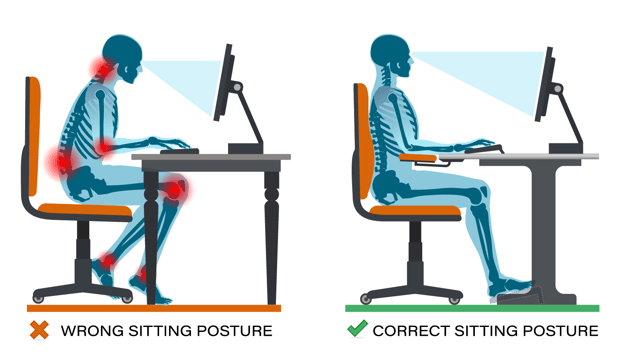WFH or RTO—Ergonomics Matters
When COVID brought the world to an abrupt halt followed by a 90-degree uncharted turn, the world adapted and continued on. For a large portion of people, that meant working from the safety of a home office.
Over half of the people working from home say they would like to either continue remote work or a hybrid between home and the office.
With so many working remotely, new digs for the home office may be in order. Working from the couch on a TV tray or sitting in the middle of the bed typing up a report can cause neck and back strain, carpal tunnel, headaches and poor posture. Ergonomically correct equipment is important, whether at the office or home.
 `
`
Why it Matters
Ergonomics, when referring to the work environment, means optimizing how you work. It includes physiology, data, and engineering that help design a work environment for better productivity and better health.
Posture is the structural framework of your body that you will carry around with you forever. Good posture is important to overall health, whereas poor postural design is associated with structural decline. Poor posture can also impact how positive and confident you feel.
Poor posture doesn’t have to cause immediate pain to have
long-term consequences such as:
• Advanced spinal degeneration
• Reduction in productivity
• Heightened risk of injury
• Lowered metabolic rate
• Higher rate of absenteeism
• Irreversible damage
• Respiratory dysfunction
• Postural aging
Workers who are subject to poor ergonomic environments are predisposed to preventable injuries and long-term health complaints. Both are avoidable with an ergonomically correct design.
The American Posture Institute states ergonomic design is “undeniably beneficial for employees and corporations at large.” An employer who implements an
injury program that includes ergonomic design can expect a return
on investment of up to 6 times the initial fees.
Ergonomically Organizing Your Workspace
The quality of your work will improve if you have the proper home office ergonomics. It will also boost your mood and your productivity and decrease frustration.
When you are organizing your home/work office, make sure the things you are using the most are close by, and the less frequent things are in drawers.
Set yourself up for success. Just putting a computer, printer, pens, paper, and coffee mug on a flat surface in your home/office doesn’t mean it’s adequately set up to avoid injury.
Desk Height – You can use a desk, corner desk, or adjustable laptop stand for your computer. The proper position of the desk is when you can use the keyboard with your elbows bent at around 45 degrees.
Chair – A quality chair is important to ensure you keep the correct posture. Proper sitting means that the floor or a footrest should support your feet. Your legs should be at a 90-degree angle so you can relieve pressure from your back.
Also important is good lumbar support that is adjustable. You should not be straining any joints or have pressure at the back of your knees when reaching for things or typing. Your knees should be slightly higher and almost a fist away from the edge of the chair’s seat.
Thighs should be parallel to the floor, and your hands and wrists should be in line with your forearms when seated. This helps prevent injuries that happen with repetitive motions.
Monitor Distance – The preferred distance of your monitor is 20 inches. The top of the monitor should be just above eye level, so your eyes are directed slightly downward to avoid neck and eye strain.
Lighting – Your home office should have enough lighting that you can see the monitor and keyboard without straining. Honestly, there is nothing better than a backlit keyboard so you can work in dimmer conditions, but not everyone will have that.
Avoid placing your monitor in a position that will cause glare either from a window or light. Use natural light when you can, and if you can’t get away from a window glare, install horizontal blinds that you can adjust at the right angle to divert the light.
Periodic Breaks – The 20/20/20 rule is popular among ergonomic enthusiasts. It means, for every 20 minutes you look at your computer, spend 20 seconds looking at something else 20 feet away. Place a picture or something that makes you smile at the proper distance, so you get a mood boost when you look at it.
Remember to move. Get up and walk around. Go outside and take a walk around the block. If you have stairs, climb up and down them a few times. Do some burpees or jumping jacks, or spend a few minutes doing really good stretches.
Break time and adjusting your position can perk you up, enhancing your well-being and boosting your productivity and creativity.
For more tips and tools to ensure an adequate ergonomic setup of your office, you can try these resources:
https://www.cdc.gov/niosh/topics/ergonomics/ergoprimer/pdfs/Computer-Workstation-Checklist.pdf
https://www.cdc.gov/niosh/topics/ergonomics/ergoprimer/default.html
https://www.osha.gov/SLTC/etools/computerworkstations/index.html
Sometimes you have to make do with what you have available to you. In that case, it’s important to know some DIY options.
-
If you must sit in a hard chair, use a cushion that provides support and comfort. Use a pillow or a rolled towel for lumbar support, and if the chair does not have armrests push the keyboard and mouse further back on the desk so you can rest your forearms.
-
Use a firm surface such as a dining table or a countertop to place your laptop and ensure the work surface edges are not sharp. Sharp edges are hard on pressure points and forearms.
-
Consider connecting your laptop to a monitor or tv screen and use an external keyboard and mouse so you can position things at a comfortable level.
-
If your feet dangle from the chair, use a footrest. You can make one from reams of paper or sturdy boxes or a step stool. You should have a right angle at your hips and knees, and your feet should be comfortably supported.
If working from a home office is going to become the norm, it would be prudent for employers to consider how they can support ergonomically correct equipment in a home office.
The results of a well-organized, ergonomically correct workspace benefit everyone.
Happy and comfortable employees are more productive and
get work-related injuries less often. That is a win for everyone!
When you partner with Ulliance, our Life Advisor Consultants are always just a phone call away to teach ways to enhance your work/life balance and increase your happiness. The Ulliance Life Advisor Employee Assistance Program (a total Well-being Program) can help employees and employers come closer to a state of total well-being.
References
Anand Subramanian, B. F. (2020, April 01). Ergonomics Recommendations for Remote Work. Retrieved from EHS Today: https://www.ehstoday.com/health/article/21127667/ergonomics-recommendations-for-remote-work
Cooper, A. (2020, December 12). The importance of good ergonomics. Retrieved from The Homeworker: https://www.thehomeworker.com/the-importance-of-good-ergonomics-when-working-from-home/
How the Coronavirus Outbreak Has – and Hasn’t – Changed the Way Americans Work. (2020, December 9). Retrieved from Pew Research Center: https://www.pewresearch.org/social-


